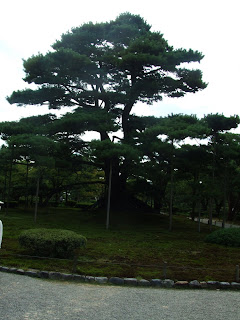My Adventures in Japan Part 6: Ishikawa

I went to
Ishikawa Prefecture last Friday. I stayed for three days. Ishikawa is in the
Hokuriku region of Japan. As you can see from the map below, Ishikawa is on the
Sea of Japan.

Hideki "Godzilla" Matsui, a famous Japanese baseball player, is from Ishikawa.

I arrived in
Kanazawa at about noon and picked up a rental car. The car was a special type of car. This type of car is called a
keijidosha, K-car (
軽自動車,). Many people in North America would be confused by this name because Chrysler used to make a car called
K-car. My mother had a K-car. The Japanese K-car is different. It's a very small car. It has a small engine. It can't go very fast.

The first place I visited was Notojima. Notojima is part of the city of
Nanao. Nanao means "seven tails". I went to the Notojima Aquarium. Business was very bad. Only a few people were there. All the exhibits wee closed. Perhaps people are afraid to visit this area because of the
2007 Noto Earthquake. There were many signs that said 「がんばっています!」, "Ganbette imasu!". This is very difficult to translate into English. In this case, "ganbette imasu" is closest in meaning to "we are persevering" in English. I felt badly for the people of Notojima but I was happy that it was it was so peaceful and quiet.


This picture was taken near the Notojima Bridge.

After I looked around Notojima I went to
Wakura onsen. The picture above is a picture of the room I stayed in. My hotel had a rotenburo (露天風呂). A rotenburo is an outdoor bath. I could see the sea from the bath.

I drove around the Noto Peninsula. Along the way I saw the building below. It has a thatched roof. The interior is very nice too. It is in a place called Mitsui no Sato.



The picture above is a picture of an
irori (囲炉裏). An Irori is a cozy place to have tea.

The country-side in Ishikawa is really beautiful. There are many rice paddies. The rice is ready for harvest now.


You can see a lot of traditional Japanese architecture in Ishikawa. In fact, many of the buildings are new but built in the traditional style.

The landscape of Ishikawa is very dramatic. You can see many interesting rock formations.



I took a short boat tour around the coast of Genmon. The rock formations were amazing.




Some of the rocks along the coast of Ishikawa were formed by lava flows. The picture above shows rock made from hardened lava.

After the boat tour I went to Nagisa Driveway. Nagisa Driveway is a beach. Cars are allowed to drive down Nagisa Driveway. This beach is a great beach for swimming. The water is warm and there aren't any rocks in the sea so you don't hurt your feet if you walk out into the sea.

More about my trip to Ishikawa next time!
 Hello everyone.
Hello everyone.


























































